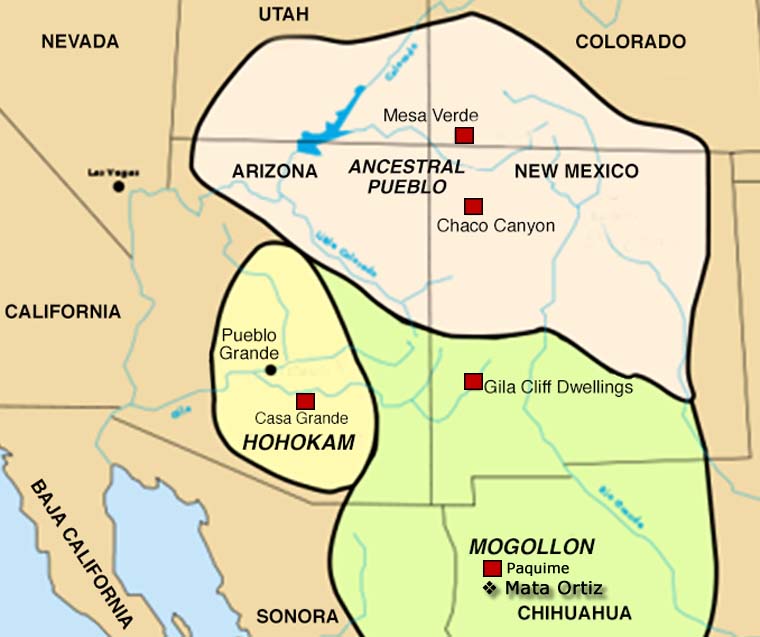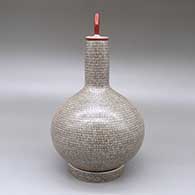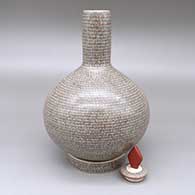
Oralia Lopez
Mata Ortiz andCasas Grandes
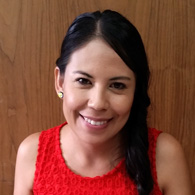
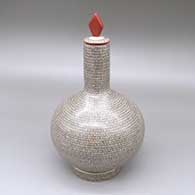
Oralia Lopez was born to Uriel Lopez and Jesus Guillen in the village of Mata Ortiz in November, 1984. She learned to make pottery as a teenager, learning from her mother and her older sister, Maribel (Lopez). Leonel Lopez Saenz (also a well-known potter) is her uncle.
Since the late 1990s Oralia has been setting the bar in Mata Ortiz for finely executed geometric designs on her jars. She uses locally-derived red, black and white mineral paints on white clay, sometimes to draw patterns of triangles and squares with such exactitude that one's eyes see a secondary design of diamonds. Oralia says her designs are inspired by the symbolism embedded in geometric patterns applied to prehistoric pottery shards that she has found lying on the ground near Paquimé. She has been doing this for so long that new variations of the old designs continually pop into her head and demand that she paint them.
Oralia's work has been shown all over the western US and in Hawaii. Pieces of hers are in the collections of the International Folk Art Museum in Santa Fe, NM, and at the Mingei International Museum in San Diego, CA.
Oralia told us if she were to make a pot for herself she would make it large and paint it with many triangles. Most of her pots that we see are small-to-medium size and painted with triangles and squares in different patterns. Many are also lidded. When we asked her what she likes to do when she's not working on her pottery she responded, "I love all animals but especially dogs. So I'm an activist in favor of animal rights."
100 West San Francisco Street, Santa Fe, New Mexico 87501
(505) 986-1234 - www.andreafisherpottery.com - All Rights Reserved

Mata Ortiz and Casas Grandes

The macaw pens at Paquimé
Casas Grandes is both a municipality and an archaeological district in northern Chihuahua State, Mexico. The archaeological district includes the pre-historic ruins of Paquimé, a city that began to build around 1130 AD and was abandoned about 1450 AD. Archaeologists are uncertain as to whether Paquimé was settled by migrants from the Mogollon/Mimbres settlements to the north or by Anasazi elite from the Four Corners region in the United States or by others. Over the years Paquimé was built into a massive complex with structures up to six and seven stories high with multiple Great Houses in the surrounding countryside. Today, the site is a UNESCO World Heritage Site.
Mata Ortiz is a small settlement inside the bounds of the Casas Grandes municipality very near the site of Paquimé. The fortunes of the town have gone up and down over the years with a real economic slump happening after the local railroad repair yard was relocated to Nuevo Casas Grandes in the early 1960's. The town was in steady decline until Juan Quezada, a poor farmer who gathered firewood in the area of the archaeological site, was inspired by fragments of ancient Paquimé pottery and even older fragments of Mimbres forms with bold black-on-white designs littering the ground to learn more.
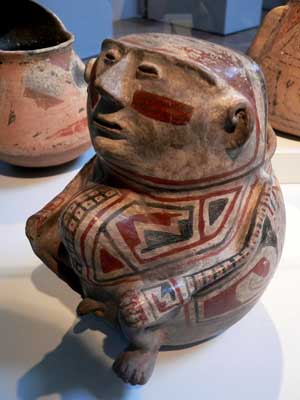
Ramos Polychrome effigy pot from Paquimé
Quezada was successful in his quest to learn to recreate the ancient process using slightly more modern techniques (although no one in the present tradition uses a potter's wheel). He learned to use sand and other coarse materials for temper. He discovered that dried cow dung made an excellent and inexpensive firing fuel. Instead of using gourds for smoothing he substituted broken hacksaw blades. Instead of using yucca fiber brushes for painting he learned to make brushes with human hair. He persevered in his efforts and by 1971 had produced a kind of polychrome pottery. Since then, most pottery-making in the area has used innovations in the design and decoration of the pots but the materials and the basic crafting of the process have remained the same.
By the mid-1970s, Quezada had attracted a significant number of traders and his work was becoming a commercial success. That is when he began teaching his techniques to his immediate family. They in turn taught other family members, friends and the younger generations. Both women and men were included from the beginning.
Originally called Casas Grandes pottery in the early years of its production, the potters of this tiny village have made such an impact on the pottery communities, including many awards and special recognition from the Presidents of Mexico, that Mata Ortiz pottery is now becoming known around the world.
Today, pottery production has changed the village in many ways as there is now electricity, plumbing, vehicles and more for the residents. Virtually everyone in the small town (2010 population: 1,182) makes their living by working in some part of the pottery-making process, from potters to clay-gatherers to firewood collectors to traders.
Mata Ortiz pottery incorporates elements of contemporary and prehistoric design and decoration, and each potter or pottery family produces their own distinctive, individualized ware. Young potters from surrounding areas have been attracted to the Mata Ortiz revival and new potting families have developed while the art movement continues to expand. Without the restraints of traditional religious practices or gender constraints, a vibrant flow of new ideas has enabled the pottery of Mata Ortiz to avoid the derivative repetition common to virtually all folk art movements. This blend of economic need, gender equality, cultural expression and artistic freedom has produced a unique artistic movement in today's community.
Lower photo is courtesy of David Monniaux, Creative Commons Attribution-Share Alike 3.0 Unported License
100 West San Francisco Street, Santa Fe, New Mexico 87501
(505) 986-1234 - www.andreafisherpottery.com - All Rights Reserved

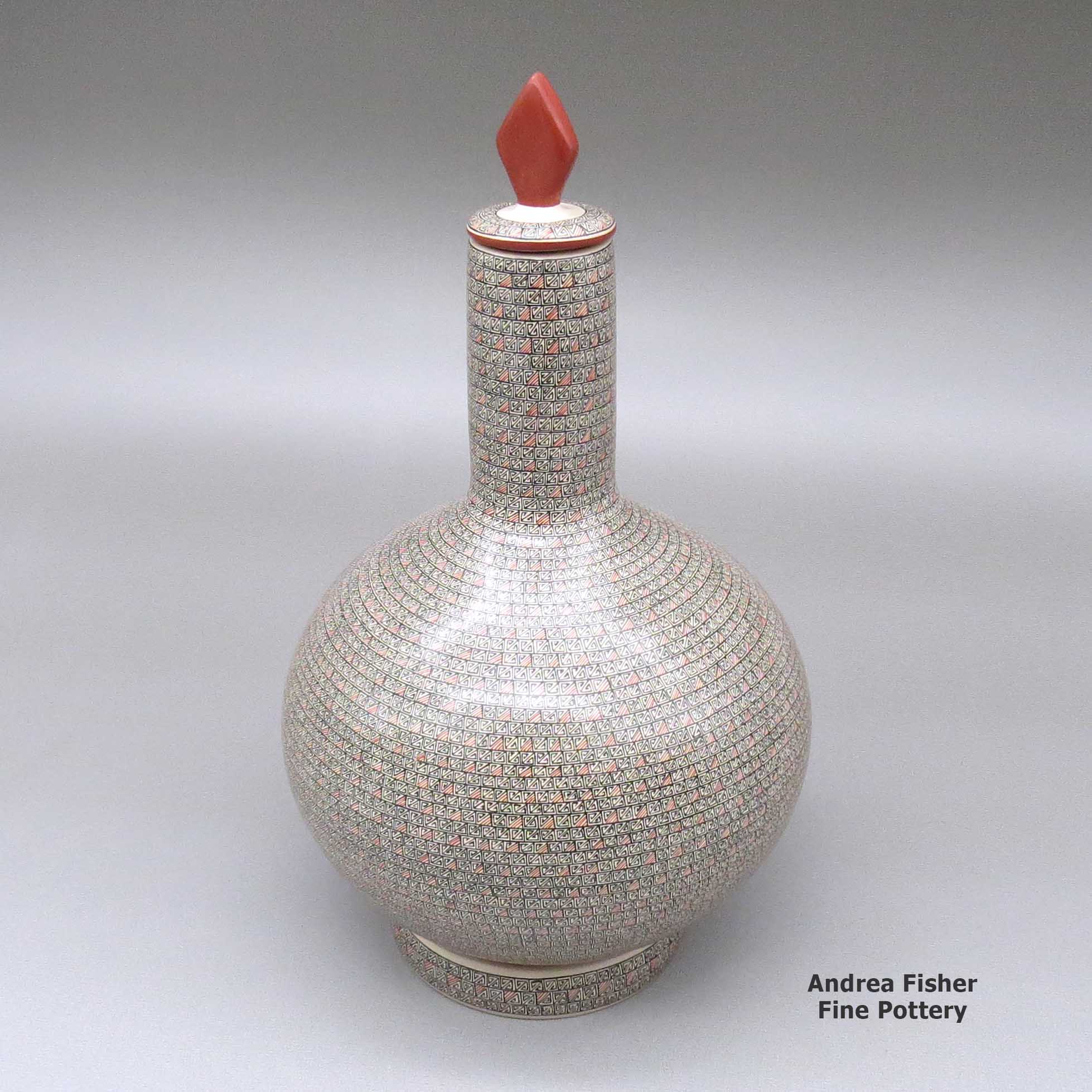
Oralia Lopez, Mata_Ortiz_and_Casas_Grandes, Polychromeliddedjarwithafinelinegeometricdesignandamatchinglidandstand
Mata Ortiz and Casas Grandes
$ 4500
zzcg4c211
Polychrome lidded jar with a fine line geometric design and a matching lid and stand
6 in L by 6 in W by 10 in H Measurement includes stand
Condition: Excellent
Signature: Oralia Lopez Guillen; signed on jar and stand
Date Created: 2024
100 West San Francisco Street, Santa Fe, New Mexico 87501
(505) 986-1234 - www.andreafisherpottery.com - All Rights Reserved

Manuel Rodriguez Family and Teaching Tree - Mata Ortiz
Disclaimer: This "family tree" is a best effort on our part to determine who the potters are in this family and arrange them in a generational order. The general information available is questionable so we have tried to show each of these diagrams to living members of each family to get their input and approval, too. This diagram is subject to change should we get better info.
- Manuel Manolo Rodriguez Guillen (1972- )
- Ricardo Delgado Cruz & Sandra Lorena Arras
- Marta Gonzalez
- Ismael Flores Ledezma
- Ismael Flores Jr.
- Arturo Ledezma
- Efren Ledezma
- Gerardo Ledezma
- Juana Ledezma
- Rafael Ledezma
- Santos Ledezma & Rosa Loya
- Jorge Alejandro Ledezma
- Leticia Ledezma
- Leonel Lopez Sr. & Elena Rodriguez de Lopez
- Abel Lopez
- Leonel Lopez Jr.
- Uriel Lopez and Jesus Rodriguez Guillen
- Maribel Lopez
- Oralia Lopez
- Rosalba Lopez
- Yesenia Lopez
- Hugo Macias
- Alfredo Freddy Rodriguez & Diana Loya
- Emiliano Rodriguez Loya
- Maria Saenz, (Diana's mother)
- Armando Rodriguez & Olivia Mora de Rodriguez
- Abraham Rodriguez
- Luis Armando Rodriguez
- Graciela (Martinez) Gallegos & Hector Gallegos Sr.
- Guadalupe Gallegos (student)
- Hector Gallegos Jr. & Laura Bugarini
- Miriam Gallegos Martinez
- Julio Mora (1971-) & Alma Soto (1974-)
- Leticia Rodriguez Mora
- Oscar Rodriguez Guillen (1970-)
- Ruben Rodriguez & Martha Ponce de Rodriguez
- Teresa Tere Rodriguez
(505) 986-1234 - www.andreafisherpottery.com - All Rights Reserved
